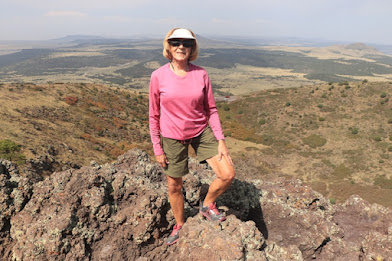 |
| Entrance to Dzibilchaltun ruins near Progresso, Mexico |
If you’re on a Western Caribbean cruise that docks at Progresso, Mexico, don’t miss an opportunity to visit Mayan ruins at the archaeological site of Dzibilchaltun. This is the oldest Mayan worship center among the 2,000 ruin sites that have been discovered from this ancient civilization (The oldest recorded Mayan date is August 13, 3114 B.C.) If you’re on a family trip, Dzibilchaltun is an easy introduction to ancient history for school-age children. There’s plenty of room to roam and opportunities to physically explore structures.
 |
| Visitors can climb on structures like this Mayan ruin. |
It was a major city for the early Maya with a
population estimated at 200,000 people. Dziblilchaltun was still inhabited by
the Maya when the Spanish arrived in the 1500s, and artifacts have been
unearthed that date from 700-800 A.D. Its history and accessibility make it a
worthwhile to visit.

Larry following two grandchildren up the steps.
Thirty-two narrow, uneven stone steps lead to the
top of the main altar; other archaeological remnants include a large piazza and
amphitheater. Temple of Seven Dolls is an imposing structure built on a pyramidal
base. The doorways were built in exact solar alignment with the rising sun, so
the rays marked planting and harvest seasons for corn, their main crop, which occur
at the spring and fall equinoxes.
 |
| Precise location of doors and windows. |
In this flat land, water filters through the soil
and makes cenotes, underwater basins connected underground. These cenotes had
spiritual meaning for Mayans, and visitors can explore some of the underground
caves during the dry season of November-December.
Guides of Mayan descent, who are typically short and
stocky, give an informative talk after which visitors can wander freely among the
ruins for an hour or two. The structures are not prohibited here as for some
other ruin sites.
Located only a 30-minute bus ride from the end of
the cruise ship pier (a long 4.6-mile man-made concrete structure), it’s a pleasant
half-day excursion. Go there instead of taking seven hours to see Chichen Itza,
where visitor activity is severely limited.Underground caves or cenotes can be explored during the dry season. Looking through a window in one structure at other ruins
Beyond the Mayan ruins, the town of Progresso is a
small fishing village, undistinguished except for the fact it’s the main port
for Merida, a bustling modern city with more than a million people. Merida is
the capital of the Yucatan, and Progresso provides the means for exporting and
importing goods. Dzibilchaltun is about nine miles from Merida, close enough to
visit both places the same day, whether you are on a cruise or traveling on
your own.
Photos by Larry and Beverly Burmeier




























